EFFECTS
OF THE ECONOMY AND POLITICS ON SOCIETY
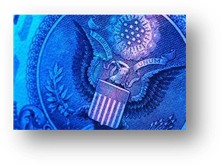
Unit Overview
Politics and the economy are driving factors in society. There are so many aspects of politics that affect our lives and our world. The economy also plays a role with us socially. Can you think of how politics and the economy affect you? As you read this unit, you will learn about how politics vary greatly and how political institutions affect us. Lastly, you will learn about role of the economy in society.
Political
Institutions in the United States
Political institutions are the institutions and organizations that a society establishes for government. They include the roles and norms that govern the distribution and exercise of power in society.

Power and Authority
In politics, a variety of people and groups gain, exercise, and maintain power, and then they also keep or lose power. In today’s world, there is constant conflict over the world’s resources, and government serves to control the conflict.
Power is a part of politics. Power is neither good nor bad. The people who have the power and the way they use it determine if it is a good thing or bad. Legitimate power is the power that has the consent of the people; it is the power that people believe and trust. Illegitimate power is exercised against the will of the people and without their approval. Individual and groups use two kinds of legitimate powers, authority and influence.
Authority
Authority is the power to enforce laws, and it requires those not in power to be obedient. Those in power have the right to judge, command, and determine what is right. Authority is formal and is established by law and tradition. Examples of people with authority include parents, teachers, employers, and others who have the right to be authoritative with people with whom they are socially associated. The Constitution provides the President with authority.
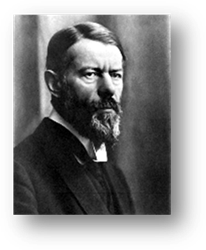
Max Weber, a sociologist, identifies three types of authority.
|
Traditional Authority |
|
Traditional authority is based on history and custom. People accept authority because it has always been that way. It is based on a long-standing custom, habit, or tradition. It is usually passed down from one generation to another. Examples include kings and queens, tribal leaders, princes, and chieftains. |
|
Charismatic Authority |
|
Charismatic authority is a result of exceptional personal qualities of a person. These people gain others’ trust and loyalty because they are persuasive, and people believe they have special qualities. These leaders often emerge during a time when society is unsettled, and they provide a hope for a better life. Examples include Gandhi, Nelson Mandela, Adolf Hitler, and Martin Luther King. |
|
Rational-Legal Authority |
|
Rational-Legal authority is based on formal rules and regulations. Laws and constitutions define the rights and duties of the ruler. Therefore, the ruler does not have power because of who he is, but because of the office or position he holds. The person loses authority when he leaves the position. This is the most common form of authority in modern societies. Examples include presidents, governors, and prime-ministers. |
Influence
Influence is the power that is gained through persuasion. Influence can be formal, such as laws or rules. For instance, laws determine the difference between bribery and legal contributions made to political campaigns. Influence can be informal, coming from wealth, fame, charm, or the knowledge of certain groups or individuals. Hollywood stars often have influence because of their wealth.
There is one type if illegitimate power, known as coercion. Coercion is when people gain power because they force people to follow them by threatening them. Coercion is a tactic that bullies, gang leaders, and abusers use.
Legitimacy is achieved in several ways. One way is through elections. When elections are conducted in a fair and honest way, it legitimizes those who are elected. When government officials are placed in office because of coercion, a rebellion from the people may result. Legitimacy is gained when leaders communicate with the people through symbols and mass communication. In is also effective when leaders create ideologies, or political plans and the devices for carrying out those plans. These actions create a sense of national unity, and the people support and become loyal to the leaders.
Governments that are sovereign are considered legitimate. A sovereign government is one that is independent from other governments; it is powerful and supreme within its own territory.
The State
When people think of a state, they usually think of a place, maybe a certain city, or the type of people who live there. According to a sociologist, a state is a set of institutions that has the power to make the rules and govern society. The state does not consist of one ultimate authority; rather it is a group of institutions that define rules and boundaries for society. The state includes local governments, the central government, the legislature, the executive, the police, the judicial system, and the armed forces. Some also consider schools, trade unions, and religious groups as part of the government.
Two views of the state include the functionalist point of view and the conflict perspective.
Functionalists believe that social order is necessary in society, and the state performs four functions of social order.
1. Enforcement of Norms: A system of formalized laws determines what violates social norms. The political authority of a state enforces those laws. For instance, laws define what constitutes rape and when the FBI should be involved. This is our complex society’s way of enforcing a norm against forcing a person to engage in sexual activity against his or her will.
2. Planning and Coordination: In order to keep a large society running smoothly, the state needs to provide mechanisms for planning and coordinating its numerous activities. Our society is large and complex; therefore, the state needs to have organization in place so that society runs smoothly. Examples include the organization of public works, the maintenance of highways and dams, air traffic control, military preparedness, and emergency readiness and relief. All of these important activities are coordinated by the government.
3. Regulation of Conflict: Each state possesses various resources, some may be rich in oil, some produce, others coal, etc. Allocating these resources can be difficult, and conflicts can arise because of it. Therefore, the state addresses and resolves these conflicts through its institutions. The state is most successful when conflicts are resolved and the people involved see the solution as fair and unbiased. For example, when it comes to drilling for oil, environmentalists, politicians, and oil companies have different viewpoints. State and national lawmakers, government bureaucrats, environmental protection groups, industry groups, and concerned citizens all have a role in resolving this conflict.
4. Conducting Relations with Other Societies: When we think of foreign policy and defense strategy, we think of the decisions made in Washington, D.C. However, in order for the U.S. to come together as a nation, the states have to determine and resolve any issues regarding their interests and concerns. The states need to make their beliefs, concerns, and wants clear so that they can be communicated with others, and all can come together as one nation. For example, when the North America Free Trade Agreement (NAFTA) was formed, the U.S. Presidents (Clinton and G.W. Bush) had to negotiate with Congress, state legislature representatives, and union lobbyists, among other groups, including the governments of Mexico and Canada.
The conflict perspective looks at the fairness of the activities among the institutions in the state. Some sociologists believe that different groups within a society, such as children, women, and the disabled, have representation through various institutions in the state. These would include family services, vocational rehabilitation centers, and other state agencies. They believe that there is a balance among conflicting groups, and the systems for expressing needs and negotiating among conflicting demands are in place to achieve smooth operation. They view the state as serving the interest of the groups within it. Some sociologists see the state as captive to the special interests within it.
Marxist conflict theorists see the state as serving the interests of the ruling class. They believe the people in power will worry about their own economic interests and social wants, so they pass laws to protect these needs. As a result, class differences are exaggerated. Marxists believe that instead of using legitimate power, the state uses coercion to maintain the ruling class. For example, striking workers may be forced to return to work using troops or executive orders. This benefits the big businesses at the expense of the working class.
History of State
Government
The timeline below shows the history of the state government.
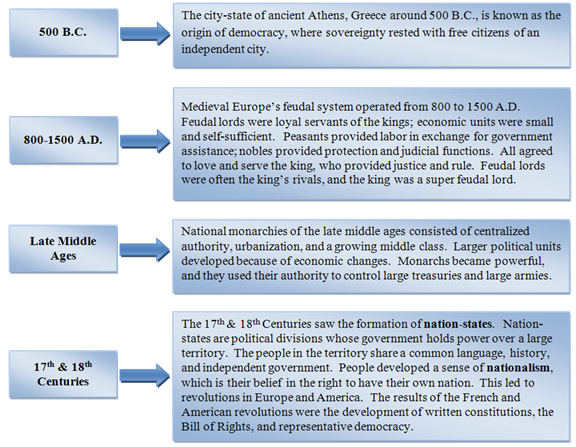

Types of Government
Governments range from democratic, which is the most liberal type where citizens have authority, to the most oppressive type, which is totalitarian, where citizens do not have rights.
In a democratic government, authority is given to the people of the state. People participate either directly or indirectly in their own governance. In a representative democracy, citizens can choose or elect representatives to voice their political concerns and make decisions. In a pure direct democracy, all citizens are directly involved in the decision making process. The governments of the United States and France are representative democracies. An example of a direct democracy would be a town government in New England. In a democracy, the key to success is keeping the checks and balances of the three branches of the government system. In addition, the states must share in the power.
In a monarchic government, a single family passes on power from one generation to the next. A constitutional monarchy is where the monarch is a symbolic head of state, but the political power actually lies within the governmental constitution. In an absolute monarchy, the ruler governs the country without any legal restrictions. Constitutional monarchies can be found in Japan, the Scandinavian countries, and Great Britain. Absolute monarchies are found in Jordan, Saudi Arabia, and Kuwait. In constitutional monarchies, the monarchs need to keep the people’s concerns in mind. For example, the people of Great Britain are concerned about the excessive spending of the royal family.
In an authoritarian government, the rulers limit citizen participation in government. Leaders are chosen by inheritance, by pre-selection of a former leader, or by being a part of a small, elite group that assumes power, known as an oligarchy. Leaders are also military officers who seize power, known as a junta. Examples of dictatorships include Ferdinand Marcos in the Philippines and Juan Peron in Argentina. Countries that are under the rule of a junta include Nigeria, Chile, and Myanmar (Burma). Military junta or oligarchies often succeed dictatorships. People in these countries have no legal power to remove the leaders, and revolutions are often the result.
A totalitarian government is a government which sees itself as having limitless power and control over all aspects of people’s lives. The government controls information, and there is no organized opposition. Anyone who disagrees with the government is dealt with harshly. Travel both outside of and within the country is tightly controlled. Examples include Saddam Hussein’s rule of Iraq, Stalin’s rule of the Soviet Union, and Mao Zedong’s rule of China. Totalitarianism is fairly recent. Because of the development of technology, the government can control the mass media and large populations.
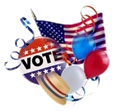
Political
Participation in the United States
The citizens of the United States determine the representative democracy. The country was founded on the principles of democratic rule; however, the participation of the voter age population (VAP) is steadily declining. On average, less than half of the VAP votes. Reasons include a lack of interest in the issues, people being too busy, people not believing their single vote matters, people believing that no candidate deserves a vote, or not registering to vote. A lack of participation in government can pose a threat to democracy since it may lack legitimacy. A lack of VAP participation may mean that people are satisfied with the status quo.
Political Parties
Political parties
are organized groups of people who work together to win elections and influence
public policy. Political parties recruit
people to support a platform, which
is a set of policies that the party stands on.
They nominate candidates and raise money in order to present their
candidates and views to the public. They
recruit and recommend responsible people for government service, and they
provide a continuation of government from one administration to the next. European countries have ten or more parties,
but the
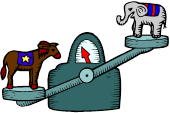
There are differences between Republicans and Democrats. Republicans
are known as the right, or conservative group.
They value local solutions over national ones. They seek to reduce government spending in
social areas and increase it in military areas.
They favor business interests over labor interests and argue for tax
policy that encourages in an investment in the economy.
Democrats are known as the left, or liberal group. They emphasize the national government’s role in social welfare. They look for solutions to poverty and unemployment. They claim to represent minorities, and they support organized labor. They favor tax programs that take from the rich and give to the poor.
Independents are those in society who do not wish to belong to either party. They may agree and disagree with the views of both parties, so they find it difficult to join one or the other. They tend to vote based on candidates’ credentials and views rather than by party lines.
Interest Groups
Interest groups attempt to influence the political decision-making process. They are organized groups of people who represent a variety of issues, such as business, labor, environmentalists, senior citizens, etc. Examples include the National Rifle Association (NRA), tobacco growers, and the National Organization for Women (NOW). These groups serve three functions. First, they provide a voice of society to government officials. Second, they educate legislatures about specific issues and give them information so that they can make informed decisions. Lastly, they pressure legislatures to consider issues that otherwise would be ignored.
Interest groups influence policy in several ways. They encourage people to call or write their government officials. They use media and advertising to influence society’s views. They file lawsuits as a means to stop legislation that is not in their interests. When they find political candidates who are sympathetic toward their cause, they work for them and donate money toward their campaigns. Lastly, they hire lobbyists to directly influence public officials.
Our constitutional rights of free speech and free association support interests groups. They join people together to influence our government. Most interest groups are Political Action Committees (PAC), which collect and distribute political campaign contributions. Currently, there are around 4,000 PACs. In the 2000 congressional election, PACs gave more than $245 million to the candidates, which was a quarter of all the campaign funds raised.
The overdoing of donations by PACs is known as influence peddling. They buy the support of candidates by giving contributions and other favors. According to sociologists, PACs affect the government in several ways. The pluralist theory is that PACs give many different groups a say in the political process. The power elite theory is that PACs stack the deck against challengers whose interests are unknown. The conflict theory states that PACs favor upper-middle class citizens because the low-class people do not have the resources or the organization to compete equally.

The Economy in the
United States
An economic institution is a system that is developed to satisfy the people’s needs and wants. A system of roles and norms governs the production, distribution, and consumption of goods. It includes the values, beliefs, norms, and activities that regulate an economy. The economy is the production, distribution, and consumption of services and goods in society.
The Industrial Revolution greatly influenced the economies and societies of the world. It had five key effects.
|
Changed Demographics |
|
|
Changed the Nature of Work |
Hand work and agricultural work changed to factory work and other jobs that required a formal education. |
|
Changed Human Relations |
People moved to cities and formed larger communities. |
|
Raised the Standard of Living |
Everyone could afford to buy more, because many more goods became available at lower prices. |
|
|
Traditional ways of living were being replaced with the increasing pursuit of material things. |
Recent changes in the world have affected economics, creating
a postindustrial society. First, there
is a new focus is on information rather than manufacturing. An example is E-commerce (electronic commerce).
This is business conducted over the Internet; it is completely based on
information. “Dot.com” companies have
made many people wealthy, but others lose money when the companies do not meet
earning expectations.
Another change has been the globalization of the economy. This has developed because of modern technology, air travel, computers, the Internet, and satellite communications.
Advertising has changed over the years, and it has also affected the economy. By 1998, businesses spent more than $330 billion on advertising, which is a huge increase from the late 1960s when that figure was $50 million. Advertising on the Internet is reshaping the economic community. It is a multi-billion dollar industry.
The Three Aspects
of the Economy: Production

Production includes work that creates products or provides services. There are three types of production systems:
- Primary Production
Primary production generates and obtains resources from the environment. Examples include fishing, mining, agriculture, and logging.
- Secondary Production
Secondary production creates goods from raw materials. Examples include factories, steel mills, automakers, and food processors.
- Tertiary Production
Tertiary production provides services rather than goods. Examples include doctors, teachers, personal trainers, and store clerks.
The Three Aspects
of the Economy: Distribution
A distribution system is society’s system for getting goods and services from the people who produce them or offer them to those who need them or want them. In democratic societies, goods are readily available. In communist societies, the government controls how and in what quantity to move agricultural products from countryside to cities.

The Three Aspects
of the Economy: Consumption
The process of accumulating goods and services is known as consumption. Consumption begins with people’s needs for products, such as food. In developed countries, it is based on wants of people. People can become materialistic and develop the conspicuous consumption attitude. This attitude is when people want to express a social standing by having, displaying, or consuming goods and services beyond one’s own needs. This includes purchasing designer clothes, expensive cars, high-end jewelry, extravagant homes, or expensive home furnishings.
Three Types of
Economic Systems
Government and economics go hand-in-hand. There are three types of economic systems in the world. The first is capitalism.

Capitalism includes competition in the production and distribution of goods and services and the private ownership of property. Supply and demand determine prices. A high demand for a product and a small supply raises prices. A low demand for a product and a high supply lowers prices.
The Law of Supply states that producers will supply more products when they can charge higher prices. The produce fewer products when they can charge lower prices
The Law of Demand states that consumers will demand more of a product as the price of it decreases. Consumers demand for a product decreases as the price increases.
There are three forms of capitalism.
|
Unregulated Capitalism |
Trade is unrestrained and production is not regulated. It leads to a monopoly where a business has
too much power. It causes its
competitors to close up and becomes the only source for consumers. As a result, the monopoly can charge as
much money for the product and supply as little or as much as it wants. |
|
Welfare Capitalism |
Government assures worker compensation, fair competition, and welfare for the consumer. The government also oversees working conditions and environmental issues. Governments often have problems finding a balance between letting companies operate as they wish and interfering with safeguards and regulations. Examples include the United States, Canada, and Great Britain. |
|
State Capitalism |
The government controls competing imports, which can lead to other countries finding fault with the fairness of their choices. Companies are owned by private citizens, but the government gives financial assistance. Examples include Japan and Korea. |
Another economic system is socialism, or the centrally-regulated economy. Under socialism, production is controlled by the state. Centralized planning controls the distribution of goods and services. Personal profit is not the goal; the goal is that all citizens share in both work and profits. Socialism supporters claim that their view controls inflation, keeps employment rates up, and keeps growth steady. In reality, these benefits are never realized. The ultimate goal of socialism is communism. Examples include the former Soviet Union, Cuba, North Korea, and China.
The third economic system is a mixed economy, or democratic socialism. The state owns the largest industries and corporations so that all citizens benefit. Examples include health care, transportation, media, and utilities. Smaller companies are owned privately. Taxes are high, but public programs like housing are low in cost, and pensions are available for retired people. Examples include Sweden, Holland, Germany, France, and Italy.
Sociologists’ Views
on Capitalism
Functionalists believe that the free competition of products forces businesses to produce the best possible goods and services and sell them at the best price. It also helps them become efficient with resources and productive.
Conflict Theorists believe that workers may feel distant in their efforts because they do not have any control or ownership over the products they produce. Private ownership benefits the owners who can keep workers’ wages low in order to increase profit.
Interactionists such as Max Weber, observed early U.S. Protestants’ hard work and their ability to invest their profits in workplaces, which in Weber’s view, led to capitalism.
The U.S. Economy
and Work
Sociologists are interested in how the economy affects people’s attitudes, values, and goals. They are also concerned with whether or not people feel satisfied.

A Strong Economy
The U.S. is a capitalist economy. Its success is evaluated in two ways. The first is the Gross Domestic Product (GDP). It is the total dollar value of all goods and services that is produced in one year by a nation’s people. The second way that success is evaluated is a nation’s productivity. Productivity is a nation’s efficiency in producing goods and services. Productivity is the ratio of output to input. Output refers to the GDP and input refers to money spent on labor and services.
When GDP is divided by population, the United States is the richest country in the world.
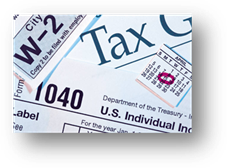
Taxes
Taxes have been around since ancient Greece. As times changed, democracy developed. People began believing that if they paid taxes, then they should have a say in how those taxes are raised and spent. The theme of the American Revolution was “taxation without representation.”
The U.S. collects taxes at every level government. Local governments usually collect funds by taxing property. Property taxes are paid on homes and even through rental costs of apartments. Cities also have sales taxes and other taxes. State governments collect income tax fees for drivers’ licenses, automobile licenses, highway tolls, and sales taxes. The federal government collects Social Security taxes and income taxes from people and businesses.
On average, business owners and corporations pay close to 50% of their profits in taxes. Citizens pay about 30% of their income in taxes. Taxes are needed for police protection, firemen, highways, schools, and bridges.
Tax policy is a major concern. When taxes are raised, people have less to spend, which affects the economy. With less spending, production is affected. When taxes are lowered, the opposite happens.

Regulated Economy
The American economy is a regulated economy, or one where the government can control certain outside forces that affect the economy. It aims at three goals in the United States:
- Protect the worth and value of the money that people earn so that they can plan to meet their current and future needs.
- Protect the economic climate, helping businesses run efficiently so they can plan for their growth and make profits for their investors.
- Provide security to foreign business partners. Protect the world from major economic turmoil which would result in massive unemployment, hunger, government breakdowns, and civil revolts and rebellions.
The Federal Reserve System (FED) is a central banking system in the U.S. They affect the economy in several ways. First, it affects economic growth by controlling the amount of money that is available. It also affects inflation, which results from the economy growing too quickly. The FEDs can raise interest rates on borrowing money, causing a reduction in spending. Lowering rates has the opposite effect.
Actions taken by the FED can impact certain aspects of the stock market. Rapid changes in stock prices are a result
from interest rate changes. This affects
people’s Individual Retirement Accounts (IRAs) since they are based on stock
market investments.
Corporate
Capitalism
Corporate capitalism refers to large business groups that dominate the wealth in the U.S. There are two types. First, corporations are formal organizations which have legal power, status, and liabilities that are distinct from the business owners and managers. Examples include Microsoft, McDonald’s, and Exxon Mobile. The second type of corporate capitalism is a conglomerate. Conglomerates are huge corporations that are made up of smaller corporations or subsidiaries which participate in different types of business. The size and affect of the different areas of business affect their influence. An example is General Electric, whose subsidiaries provide appliances, medical systems, aircraft engines, software, and broadcasting, among other products and services.
Many large businesses are multi-national corporations with sales, services, or manufacturing in one or more foreign countries. These corporations develop products locally and manufacture them abroad, reducing their costs of labor and materials and giving them trade advantages. An example includes General Motors which operates and manufactures in 50 countries. In 1999, General Motors made $176 billion.
Capitalistic Values
Capitalistic values are easily seen in the U.S. Capitalistic values refer to the ability to get ahead and the openness to diversity. It is material rewards for individual’s efforts. It is creativity in individual pursuits. It is change for its own sake, as in new and improved products.
Work and Society
Often people define themselves by their jobs. Work and the income generated from work become a person’s sense of self. The concept of work has changed from labor-based to knowledge-based. There are two broad labor markets. The primary labor market includes jobs and occupations that provide high income, prestige, and extensive benefits. The secondary labor market includes jobs that provide low wages and few benefits.
Sociologist care about the amount of job satisfaction that various types of work bring. Job satisfaction indicates society’s perception of the quality of life and the feelings that they have concerning work roles and their work’s effect on society. When people’s jobs give them self-direction and a fair compensation rate, job satisfaction rises. Repetitive jobs where employees have little say in their work usually result in low job satisfaction. Underemployment, when people accept jobs that they are overeducated for, also leads to job dissatisfaction.
Changing Jobs
The number of physical labor jobs is decreasing due to automation and environmental issues. People lose jobs and now must retrain for service jobs, such as high-tech jobs, banking, real estate, insurance, technology, and computer technology. Other jobs disappear as companies move the production to other countries where production is cheaper.
Activity
When thinking about American
politics, we always think of our presidents.
One president in particular, John F. Kennedy, never finished his
work. Read over aspects of his
presidency at the following website: https://millercenter.org/president/kennedy
Be sure to review each of the following sections on the
site:
A Life in Brief • Life Before the Presidency • Campaigns and Elections • Domestic Affairs • Foreign Affairs • Death of the President • Family Life • The American Franchise • Impact and Legacy
You may also view the information
found on this site as a PDF document.
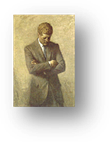
Using Microsoft Word, write a
persuasive paragraph explaining whether or not you believe American policies
and laws would be different if John F. Kennedy was never assassinated. You can also write about whether or not
American politics would be different, or discuss how things would be if he had
completed what he wanted to achieve.
Choose whatever point of view you wish, but make sure you support it
with facts from the website. Remember to
avoid plagiarism by writing all information in your own words rather than
copying information directly from the website.
The paragraph needs to be 8 to 10 sentences in length and written using
complete sentences. You will submit this assignment in the questions section of
this unit.
|
|
Now stop and answer
questions 1 through 26. |
